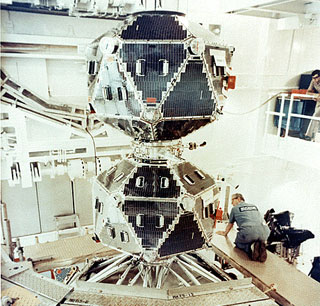A pair of Vela satellites in the clean room prior to launch: The Vela satellites are stacked one on top of the other in a clean room prior to the launch. The two polyhedron-shaped satellites (with 20 sides) would detach from each other after launch.
Credit: Los Alamos National Laboratory (LANL)
Vela is the Spanish word for “watch”. The first pair of Vela satellites went up three days after the Test Ban Treaty was signed. The satellites could detect the neutrons, X-rays, and gamma rays that would come pouring out of a nuclear blast. Since they were cheap and could be made quickly, more and more pairs went up. Eventually six pairs of satellites ended up in space, each with better ability to detect and pinpoint locations.
By March 1969, Vela 4 had been up for almost a year and Vela 5 was on the launch pad. The responsibility for the analysis of the data had long since been given to Los Alamos and no amount of persuasion by Teller would change the official decision, and so he and I were left to speculate. The analysis was in the hands of a scientist at Los Alamos named Ray Klebesadel. He was going through the data and looking at events that had triggered the detectors to make sure they weren’t from the Sun or a solar flare. Ray was checking data from Vela 4A and his colleague Roy Olson was checking the data from 4B. They found an event from July 2, 1967, that both satellites had recorded. Had the Russians tested a nuclear bomb?


